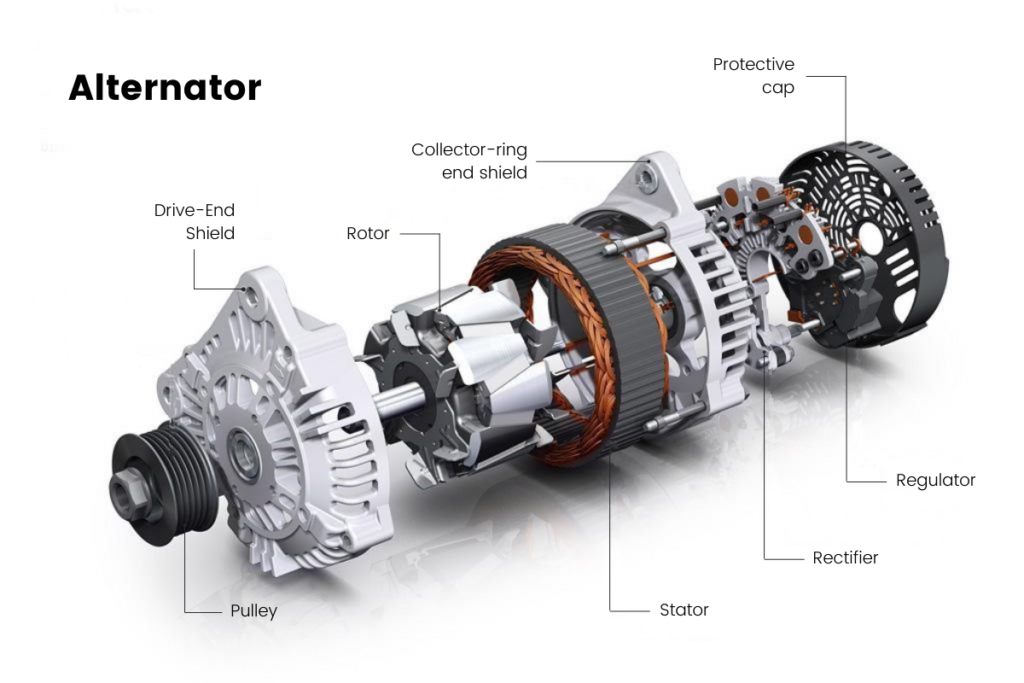Starting the car, turning up the radio, or switching on the AC are day to day actions. But have you ever wondered how this is possible? Which component is responsible for the electrical functioning of your car?
If you said battery, well, you’re wrong.
The alternator is the responsible part of the entire process. This element maintains the battery’s energy level and ensures the correct operation of the car’s air conditioning and lighting systems.
With this article, you will understand what the alternator is, its components and how it works. You will also learn how important this part is for the function of your vehicle.
What is the alternator?
The alternator is one of the most sensitive and crucial car parts. Since 1913, this component has been part of vehicles. However, most drivers only notice the influence of this part when the car doesn’t start.
Maintaining the battery’s energy level is, precisely, one of the alternator’s roles. Besides, it also guarantees the electrical functioning of your vehicle’s climatization and lighting systems.
In some car models, the alternator is also responsible for the power steering activity.
So, the alternator transforms the mechanical energy, produced by the engine, into electrical energy. Then sends power to the components when the car is running. In this way, the alternator controls the electronically produced voltage while it rectifies the electric current.

How does it work?
The alternator must be connected to the engine crankshaft by a belt to convert mechanical energy into electrical energy.
The alternator consists of a rotor with permanent magnets surrounded by a stator, whose magnetic field generates electric current through the rotational motion of the rotor induced by the crankshaft. Since it depends on movement, the alternator only produces power when the engine is running.
In the rotor, there are also brushes, which send the electricity generated to the rectifier and voltage regulator. The regulator adjusts the output voltage and current, avoiding power surges that could damage the components.
In short, when the engine is rotating, the alternator uses the serpentine belt to transform the motion into electrical energy. In turn, the electricity generated is directed to the battery.
Read also: 10 Myths about cars: Part 1
Alternator elements
The part is constituted of various components shielded by the protective cap. The main elements of the alternator are the following ones.

Pulley
Circular component, fixed on the rotor axle, which spins according to the engine’s rotational speed, by a serpentine belt.
Stator
It’s a circular structure responsible for electrical current creation.
The stator, made of iron or silicon alloys and enamelled copper wires, consists of several isolated coils attached to a set of blades. In these coils is induced the electric current, created by the rotation of the rotor.
Be aware of potential short circuits between the coils and the blades since they compromise the electrical current flow.
Rotor
A magnetic field is required for the stator coils to generate power. The rotor, therefore, has the task of forming a polarised magnetic field that creates an electric current.
Short circuits can also occur in the rotor. But, in this case, it can cause a reduction or even the absence of the ability to generate electric current.
Rectifier
This part transforms alternating current, generated by the alternator, into direct current. This energy is used to charge the battery and power other electrical components in the car.
The rectifier also protects the battery from possible discharge by blocking the passage of its electrical current to the alternator.
The most common problem with this part is burnt diodes which make the board inoperable.
Regulator
This component controls the voltage generated at the engine’s speed. Therefore it prevents current peaks from occurring and consequently the battery from overcharging.
Serpentine belt
The alternator belt is a crucial element of the alternator because it connects this part to the engine.
However, its functions differ depending on the brand of the vehicle. For example, in some car models, the alternator belt is also responsible for transmitting energy to the power steering pump and the air conditioning compressor.
Read also: Engine Control Unit: what is, the features, and possible failures
Conclusion
After knowing how the alternator works, do you understand the importance of this small part?
The alternator has been an integral part of the car for more than 100 years, but its influence is increasing every day. The list of elements that run on electricity is growing all the time.
Air conditioning, parking sensors, automatic headlight regulation, on-board computer, seat heating and boot opening control are examples of accessories that offer comfort and safety to passengers. At the same time, they are also items powered by the alternator.
Therefore, pay careful attention to your car’s alternator to guarantee the correct functioning of these extras and that your vehicle continues running.

